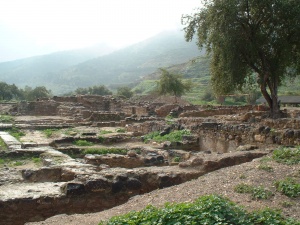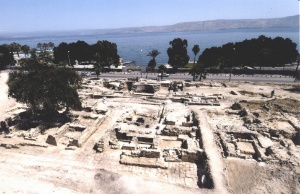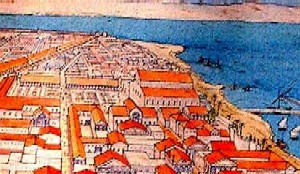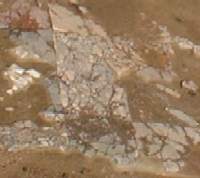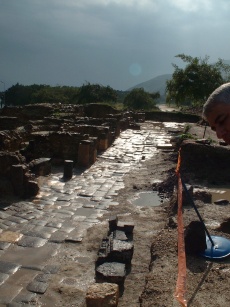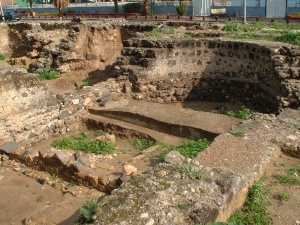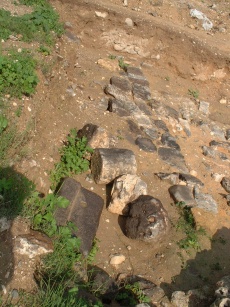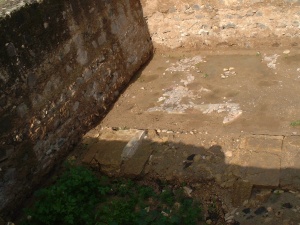Newly discovered ruins of the Sanhedrin at Tiberias
For hundreds of years after the destruction of the Temple, the Sanhedrin assembled in various cities. In 270 C.E. it moved to Tiberias. In 358 C.E. Roman Emperor Theodosius disbanded the Sanhedrin and confiscated their property, as a reaction to previous emperor Julian's pro-Jewish stance. The modern Jewish Calendar was adopted at clandestine, and maybe last meeting, in the caves of Mount Berenice overlooking the city. The Sanhedrin complex is believed to have been converted into a Christian structure shortly after that.
Further revelations of the beauty of the ancient city of Tiberias and of its uniqueness as a Jewish center were revealed in this season's excavations there. The excavations, funded by the Tiberias municipality, are turning the site into a significant archaeological park, according to dig director Prof. Yizhar Hirschfeld of the Hebrew University of Jerusalem and the Israel Antiquities Authority, and Prof. Katharina Galor of Brown University, Providence, RI.
Excavations at ancient Tiberias, showing the "Galilee Street," and the basilica complex, with the Sea of Galilee in the background.Ancient Tiberias' location, just south of the modern city of Tiberias along route 90, was highly attractive in Roman times: on one side open to the Sea of Galilee (Lake Kinneret) and on the other bounded by Mount Berenice. Two main north-south streets dominated the city plan. One was the cardo, the main commercial thoroughfare of the town. The other was the promenade, which was open on one side to the lake and over which route 90 was built.
Excavations this year focused on the city's basilica complex, which was first discovered several years ago and is identified with the seat of the Sanhedrin, the ancient supreme Jewish religious authority. The eastern wall of the structure was preserved to a height of two meters and was bounded by the promenade.
The structure itself was built in the 4th century C.E. as a gigantic complex of at least 2,000 square meters. It has some 25 rooms with three main components: a colonnaded courtyard, which served as a gathering place for the townspeople, a passageway, and a reception hall with a semi-circular apse. Under the courtyard, excavators found a water cistern, supported by arches, that has survived the centuries unscathedBeneath the apse hall, remains of an impressive, first-century, marble floor were found.
There is no natural marble in Israel, and therefore, this floor must have been part of a grand structure belonging to an individual of extraordinary wealth. The excavators believe it was one of the palaces belonging to Herod Antipas, son of Herod the Great, who founded Tiberias in 20 C.E. A marble floor of this type from the Second Temple period has been found previously in Israel only at the Herodian palaces of Masada, Jericho, and Herodion.The finds in the remains of the complex's ancient shops this season were extremely rich: complete oil lamps, bronze coins, including more rare coins from the 11th century, (discovered in earlier excavations there), glass and stone vessels, jewelry and frescoes. On the western facade of the basilica complex, a row of shops was discovered along with a 50-meter section of street paved with basalt stones, which the archaeological team named "Galilee Street."
Haaretz (Hebrew) reported that in excavations this week (March 9th) at Tiberias, archaeologists discovered a mosaic containing a picture of a lion or dog, a flying dove, and grapevine branches with grape clusters. The mosaic, dating to the 4th century CE, was uncovered in a semicircular niche in the basilica structure, where scholars believe the Sanhedrin was operating, after it had moved to Tiberias in the 3rd century CE. The archaeologists say that this shows how beautiful the basilica must have been. Unfortunately, a wall built later divides the mosaic. An inscription that may have originally been written in the mosaic has been destroyed and all that is left is a corner of the frame inside of which an inscription was possibly present.
Excavation director Prof. Yizhar Hirschfeld from Hebrew University of Jerusalem says the basilica, which was built during the third century C.E., could have been used by the Sanhedrin, which at the time was called Beit Hava'ad. Identical structures, such as one at Beit Sha'arim, were also used for judicial purposes. In Tiberias the site could have also be used for writing the Jerusalem Talmud, researchers believe.
Supporting theory
Prof. Aharon Oppenheimer, a historian from Tel Aviv University whose field of expertise is the Talmud-Mishna period, recently visited the Tiberias excavation and supports the theory that the basilica was the home of the Sanhedrin.
Archaeologists have in recent days also discovered a mosaic at the entry to the large bath house of Tiberias. Green and yellow hues in the work come from glass mosaic tiles; vines bearing fruit are drawn on the mosaic. Another mosaic discovered in the bath house during the 1950s was not preserved - it had pictures of animals (lions and elephants).
The archaeological team has also started to document dozens of stone doors, which were lined up along roads in the city. One theory holds that they were doors of family burial caves (doors were used for similar purposes at Beit Sha'arim).
Prof. Hirschfeld believes the caves were destroyed in a major earthquake in 363 C.E., and the stones remained as decorated pillars.
Based on a Hebrew University of Jerusalem public release[1] Contact: Jerry Barach, jerryb@savion.huji.ac.il, +972-2-5882904. See their new website[2] and old website[3] and newpaper reports.[4][5]
